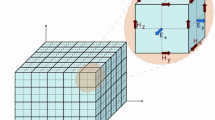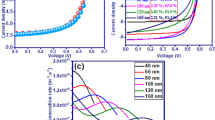Abstract
The increase in optical absorption in organic solar cells based on poly (3-hexylthiophene): phenyl-C61-butyric acid methyl ester (P3HT:PC61BM), is examined in this study utilizing the finite difference time domain method and Lumerical software to evaluate field distribution and light absorption in the active layer in terms of wavelength. The plasmonic impact on the metal surface, as well as the positioning of plasmonic crystals in different areas, as revealed by finding a favorable site for a plasmonic crystal and refining the structure, results in a significant increase in absorption in the optical region. The impact of active layer thickness, the distance between neighboring nanoparticles, and plasmon crystal on the active layer of the polymer solar cell were examined. The proposed triangular, wire, rectangle, and multi-period triangular Ag nanoparticles optical model can explain the optical absorption increase via localized surface plasmon resonance (LSPR) modes and get a better knowledge of the shape characteristics of Ag nanoparticles, which are crucial in determining the broadband absorption phenomena in plasmonic organic solar cells. When the plasmonic solar cell's power conversion efficiency was compared to that of solar cells without Ag nanoparticles, a significant increase was seen. The strong alternating electromagnetic field around the different plasmonic nanoparticles resulting from the LSPR suggested by the Ag plasmonic nanocrystals increased the intrinsic optical absorption in the active layer P3HT:PC61BM. The short-circuit current varied from 7.3 to 26.9 mA/cm2 based on the photovoltaic characteristics.













Similar content being viewed by others
Data availability
The data that support the findings of this study are available from the corresponding author upon reasonable request.
References
Duan L, Uddin A (2020) Progress in stability of organic solar cells. Adv Sci 7(11):1903259
Dong S et al (2019) Suppressing the excessive aggregation of nonfullerene acceptor in blade-coated active layer by using n-type polymer additive to achieve large-area printed organic solar cells with efficiency over 15%. EcoMat 1(1):e12006
Ahn S, Rourke D, Park W (2016) Plasmonic nanostructures for organic photovoltaic devices. J Opt 18(3):033001
Tang CW (1986) Two-layer organic photovoltaic cell. Appl Phys Lett 48(2):183–185
Gao Y et al (2018) An asymmetrical polymer based on thieno [2, 3-f] benzofuran for efficient fullerene-free polymer solar cells.". ACS Applied Energy Materials 1(5):1888–1892
Cho H-E, Seok HC, Sung-Min L (2020) Embedded plasmonic nanoprisms in polymer solar cells: band-edge resonance for photocurrent enhancement. APL Mater 8(4):041116
Fan Q et al (2021) Multi-selenophene-containing narrow bandgap polymer acceptors for all-polymer solar cells with over 15% efficiency and high reproducibility. Angew Chem Int Ed 60(29):15935–15943
Chen X et al (2021) Nickel and cobalt sulfide-based nanostructured materials for electrochemical energy storage devices. Chem Eng J 409:127237
Peet J et al (2007) Efficiency enhancement in low-bandgap polymer solar cells by processing with alkane dithiols. Nat Mater 6(7):497–500
Park SH et al (2009) Bulk heterojunction solar cells with internal quantum efficiency approaching 100%. Nat Photon 3(5):297–302
Chaudhari MK, Singh BK, Pandey PC (2017) Enhanced light trapping in dye-sensitized solar cell by coupling to 1D photonic crystal and accounting for finite coherence length. J Mod Opt 64(21):2385–2393
Sharma N, Gupta SK, Negi CMS (2019) Influence of active layer thickness on photovoltaic performance of PTB7:PC70BM bulk heterojunction solar cell. Superlattices Microstruct 135:106278
Hauch JA et al (2008) Flexible organic P3HT:PCBM bulk-heterojunction modules with more than 1year outdoor lifetime. Solar Energy Mater Solar Cells 92(7):727–731
Yablonovitch E, Owen DM, Sarah RK (2012) The opto-electronic physics that broke the efficiency limit in solar cells. In: 2012 38th IEEE photovoltaic specialists conference. IEEE
Andersson V, Kristofer T, Olle I (2008) Optical modeling of a folded organic solar cell. J Appl Phys 103(9):094520
Shabani L, Mohammadi A, Jalali T (2022) Numerical study of plasmonic effects of Ag nanoparticles embedded in the active layer on performance polymer organic solar cells. Plasmonics 17(2):491–504
Wong W-Y et al (2011) Metallated conjugated polymers as a new avenue towards high-efficiency polymer solar cells. Mater Sustain Energy Collect Peer-Rev Res Rev Articles Nat Publish Group 6:51–57
Zhang Z et al (2013) Plasmonic gold nanocrystals coupled with photonic crystal seamlessly on TiO2 nanotube photoelectrodes for efficient visible light photoelectrochemical water splitting. Nano Lett 13(1):14–20
Chen X et al (2008) Plasmon enhancement of bulk heterojunction organic photovoltaic devices by electrode modification. Appl Phys Lett 93(12):344
Zhang H et al (2018) Over 14% efficiency in organic solar cells enabled by chlorinated nonfullerene small-molecule acceptors. Adv Mater 30(28):1800613
Hadmojo WT et al (2019) Performance optimization of parallel-like ternary organic solar cells through simultaneous improvement in charge generation and transport. Adv Funct Mater 29(14):1808731
Zheng Z et al (2018) A highly efficient non-fullerene organic solar cell with a fill factor over 0.80 enabled by a fine-tuned hole-transporting layer. Adv Mater 30(34):1801801
Li Q et al (2017) Decahedral-shaped Au nanoparticles as plasmonic centers for high performance polymer solar cells. Org Electron 43:33–40
Chan K et al (2017) Plasmonics in organic and perovskite solar cells: optical and electrical effects. Adv Opt Mater 5(6):1600698
Krebs FC et al (2013) Freely available PSC—the fast way to progress. Energy Technol 1(7):378–381
Peer A, Biswas R (2014) Nanophotonic organic solar cell architecture for advanced light trapping with dual photonic crystals. ACS Photon 1(9):840–847
Shen P et al (2018) High-efficiency and high-color-rendering-index semitransparent polymer solar cells induced by photonic crystals and surface plasmon resonance. ACS Appl Mater Interfaces 10(7):6513–6520
Neubauer A et al (2016) Simple down conversion nano-crystal coatings for enhancing Silicon-solar cells efficiency. AIMS Mater Sci 3(3):1256–1265
Ringe E et al (2010) Unraveling the effects of size, composition, and substrate on the localized surface plasmon resonance frequencies of gold and silver nanocubes: a systematic single-particle approach. J Phys Chem C 114(29):12511–12516
Smirnov V et al (2021) Transmitting surface plasmon polaritons across nanometer-sized gaps by optical near-field coupling. ACS Photon 8(3):832–840
Riede M, Spoltore D, Leo K (2021) Organic solar cells—the path to commercial success. Adv Energy Mater 11(1):2002653
Nelson J (2011) Polymer: fullerene bulk heterojunction solar cells. Mater Today 14(10):462–470
Wang J et al (2021) Increasing donor-acceptor spacing for reduced voltage loss in organic solar cells. Nat Commun 12(1):1–9
Reyes-Reyes M, Kim K, Carroll DL (2005) High-efficiency photovoltaic devices based on annealed poly (3-hexylthiophene) and 1-(3-methoxycarbonyl)-propyl-1-phenyl-(6, 6) C 61 blends. Appl Phys Lett 87(8):083506
Reyes-Reyes M et al (2005) Meso-structure formation for enhanced organic photovoltaic cells. Org Lett 7(26):5749–5752
Mehboob MY et al (2021) Role of acceptor guests in tuning optoelectronic properties of benzothiadiazole core based non-fullerene acceptors for high-performance bulk-heterojunction organic solar cells. J Mol Model 27(8):1–16
Chidichimo G, Luigi F (2010) Organic solar cells: problems and perspectives. Int J Photoenergy 2010
Abass A et al (2011) Angle insensitive enhancement of organic solar cells using metallic gratings. J Appl Phys 109(2):023111
Kang M-G et al (2010) Efficiency enhancement of organic solar cells using transparent plasmonic Ag nanowire electrodes. Adv Mater 22(39):4378–4383
Chalh M et al (2016) Plasmonic Ag nanowire network embedded in zinc oxide nanoparticles for inverted organic solar cells electrode. Solar Energy Mater Solar Cells 152:34–41
Kim T et al (2018) Nanoparticle-enhanced silver-nanowire plasmonic electrodes for high-performance organic optoelectronic devices. Adv Mater 30(28):1800659
Hamdan KS et al (2020) Surface plasmon resonance of silver nano-dendrites improved light absorption in an organic photovoltaic active layer. Micro Nano Lett 15(12):866–871
Mola GT et al (2021) Local surface plasmon resonance assisted energy harvesting in thin film organic solar cells. J Alloys Compd 856:158172
Paul S et al (2017) Organic photovoltaic cells using MWCNTs. New Carbon Mater 32(1):27–34
Yee K (1966) Numerical solution of initial boundary value problems involving Maxwell’s equations in isotropic media. IEEE Trans Antennas Propag 14(3):302–307
N’Konou K, Philippe T (2019) Optical absorption modeling of plasmonic organic solar cells embedding Ag–SiO2 core–shell nanoparticles. Noble Met-Met Oxide Hybrid Nanopart, 265–282
Sullivan DM (2000) Electromagnetic simulation using the FDTD method. Wiley
Umashankar K, Taflove A (1982) A novel method to analyze electromagnetic scattering of complex objects. IEEE Trans Electromagn Compat 4:397–405
Moreno F et al (2008) Interaction of nanoparticles with substrates: effects on the dipolar behaviour of the particles. Opt Express 16(17):12487–12504
Maier SA (2007) Plasmonics: fundamentals and applications. Springer, Berlin
Kulkarni AP et al (2010) Plasmon-enhanced charge carrier generation in organic photovoltaic films using silver nanoprisms. Nano Lett 10(4):1501–1505
Rai P (2019) Plasmonic noble metal@ metal oxide core–shell nanoparticles for dye-sensitized solar cell applications. Sustain Energy Fuels 3(1):63–91
Abass A et al (2012) Dual-interface gratings for broadband absorption enhancement in thin-film solar cells. Phys Rev B 85(11):115449
Kluczyk K et al (2019) On modeling of plasmon-induced enhancement of the efficiency of solar cells modified by metallic nano-particles. Nanomaterials 9(1):3
N’konou K, Philippe T (2017) Optical absorption enhancement by inserting ZnO optical spacer in plasmonic organic solar cells. J Nanophoton 12(1):012502
Vedraine S et al (2011) Intrinsic absorption of plasmonic structures for organic solar cells. Solar Energy Mater Solar Cells 95:S57–S64
Lee J-Y, Peumans P (2010) The origin of enhanced optical absorption in solar cells with metal nanoparticles embedded in the active layer. Opt Express 18(10):10078–10087
Nair AT, Shamjid PP, Reddy VS (2018) Influence of Ag nanostructure location on the absorption enhancement in polymer solar cells. ACS Appl Mater Interfaces 10(38):32483–32491
Acknowledgements
We are thankful to the Persian Gulf University Research Council for continuous support.
Funding
Not applicable.
Author information
Authors and Affiliations
Contributions
A. Mohammadi designed and directed the project and, with L. Shabani, contributed to the design and implementation of the research, and A. Mohammadi, L. Shabani, T. Jalali contributed to the analysis of the results and to the writing of the manuscript.
Corresponding author
Ethics declarations
Conflict of interest
The authors declare that they have no conflict of interest.
Consent to participate
Not applicable.
Consent for publication
Not applicable.
Ethical approval
This paper does not contain any studies with human participants or animals performed by any of the authors.
Additional information
Publisher's Note
Springer Nature remains neutral with regard to jurisdictional claims in published maps and institutional affiliations.
Rights and permissions
Springer Nature or its licensor holds exclusive rights to this article under a publishing agreement with the author(s) or other rightsholder(s); author self-archiving of the accepted manuscript version of this article is solely governed by the terms of such publishing agreement and applicable law.
About this article
Cite this article
Shabani, L., Mohammadi, A. & Jalali, T. Performance analysis of polymer bulk heterojunction solar cells with plasmonic nanoparticles embedded into the P3HT:PC61BM active layer using the FDTD method. Polym. Bull. 80, 9589–9610 (2023). https://doi.org/10.1007/s00289-022-04521-7
Received:
Revised:
Accepted:
Published:
Issue Date:
DOI: https://doi.org/10.1007/s00289-022-04521-7




